The Inventor of the Curling Stick and the creator of the Sport of Wheelchair Curling
Thomas Willard “Rusty” Drew was a Huntsville resident and community volunteer. He was very active in the “Literary Council of Muskoka”, “Muskoka Heritage Place”, and was instrumental in bringing the “RCMP Musical Ride” to Huntsville. The Musical Ride organizing took 5 years with a team of 40 volunteers. In the end, it was a huge fundraiser for the Town of Huntsville and helped establish the Huntsville Junior Achievers.
Local author Susan Pryke wrote an article about Rusty’s Extender in the “CARP News Fifty Plus Ontario” magazine. From that article news of the invention of the Extender “spread like wildfire” across Canada among seniors and disabled persons. In December of 1999, for Susan’s article, Rusty said “his greatest pleasure is seeing a lot of people, seniors and disabled persons, get into curling. I started trying to solve a problem for my wife Roberta and found out a lot of people had the same problem”.
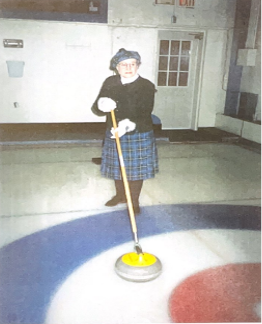
Pictured at the Huntsville Curling Club sheet 1 in 1998 is Roberta Drew with the original curling stick called the “ExtendeR” made of a broom handle and moulded plastic clip.
This newspaper advertisement dating back to 1998 era stating the stick has been approved by Curling Canada and is Patent Pending.
The ad reads “Will Keep You on The Ice” because when Rusty’s wife Roberta could no longer get down in the hack, her husband Rusty created a device he called the “ExtendeR” during the 1997/1998 season. The name ExtendeR was a suggestion by Rusty’s wife Roberta… “It not only extends a player’s curling years; it extends the revenues of the club because people can continue to curl.
Rusty added a capital “R” on the end for “R’oberta.
The Curling Stick he called the “ExtendeR” enabled a curler to accurately deliver and turn a curling rock without having to crouch in the hack. Before the ExtendeR, some curlers tried delivering a rock with their push broom upside down but there was no way to deliver a rock with a turn and no way to enjoy a successful shot. The ExtendeR had a long wooden broom handle with a plastic clip on the end that fit over the handle to allow a turn to be put on the rock when delivered.
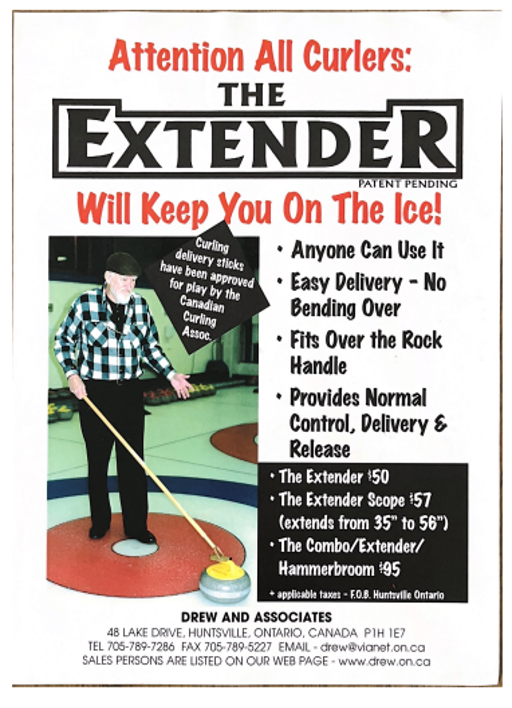
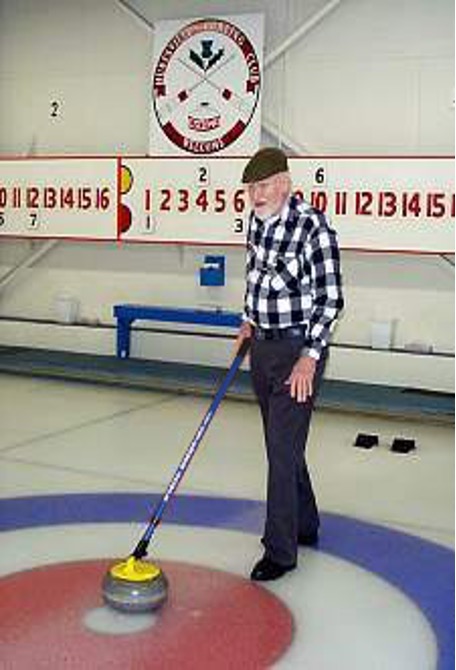
Pictured above is Rusty Drew at the Huntsville Curling Club in the early 2000’s with his “Scope” version of the Extender Curling Stick.
The first ExtendeR in 1997/1998 season was created using a broom stick with a hinged plastic moulded clip to fit over the rocks handle. The device has been modified since the original design after user input. “Various curlers at the Huntsville Curling Club “played around with it” and Rusty took the suggestions into account before arriving at the final design. Rusty was unsure if the device would be legal and contacted Curling Canada. Within two months Curling Canada approved the curling stick he called the ExtendeR and Rusty then patented the design.
Rusty took on a partner, Leo Lippel, who had a plastic mold shop nearby and they formed a company called Drew & Associates. They began manufacturing the “ExtendeR” in their shop. That first year, 37 ExtendeRs were sold, mostly to Huntsville Ontario Curling Club members and area Muskoka Clubs.
Huntsville Curling Club’s Thomas Willard “Rusty” Drew (Rusty because of his red hair) was acknowledged by the Canadian Sports Hall of Fame for Inventor in the category of Curling. The subcategory is called the “Canadian Innovation in Sport”, “Innovation – Curling”.
He was acknowledged for the invention of the curling stick he called the ExtendeR which revolutionized curling deliveries for many curlers requiring an accessibility aid. The Canadian Sports Hall of Fame also creates Rusty as the creator of the Sport of Wheelchair Curling, made possible by his curling stick invention.
Along side Rusty, are two other Curling Inventors who earned themselves a place in the Canadian Sports Hall of Fame, Inventor Category for Curling.
Elias Olson who invented the hack in 1939. Elias also was the person to begin the tradition of painted coloured rings in the house a few years later. In a Bonspiel in Saskatoon in 1939 Olson slipped having carefully prepared the perfect shot. He was so irritated at his bad luck that he became determined to resolve the problem.
By baking rubber into a thick set platform, Olson created a rubber hack embedded into the ice that was so successful all the local clubs immediately bought it and the hack became standardized throughout curling.
A true progressor of methods, Olson was also responsible for colour and painting rings on the ice, reasoning that curling would be “drab and colourless” without them and the first individual curling rock sharpening machine.
Ken Watson from Manitoba invented curling sliding shoes, one with a rubber sole, the other with a smooth leather sole. In the late 1940’s Watson was the first curler to start sliding to victory. By sliding from the hack on the leather sole of his shoe, Watson ignored convention and perfected a way of delivering his stone by sliding on the ice. By 1954, the slide delivery was a trademark of all the champions and became so important that today a range of different materials – red brick, teflon, stainless steel – are used in curling shoes to impact the slide in different ways.
Word of the ExtendeR spread quickly to the wheelchair community in 1998/1999. So fast that wheelchair curling associations formed who all endorsed the ExtendeR. In 2002, only three years after the invention of the ExtendeR, the first ever World Wheelchair Curling Championships were held in Switzerland with the ExtendeR having their endorsement.
So successful were Drew’s ExtendeR stick, only four years after he invented it, that in 2003, Drew sold over 11,000 ExtendeRs and distributed the device worldwide. The ExtendeR is still sold worldwide.
Pictured here is long time Huntsville Curling Club member Frank Spencer using one of the original broomstick “Extenders” to deliver his rock. This picture was taken in 2022. Frank says “no other stick works as well”!
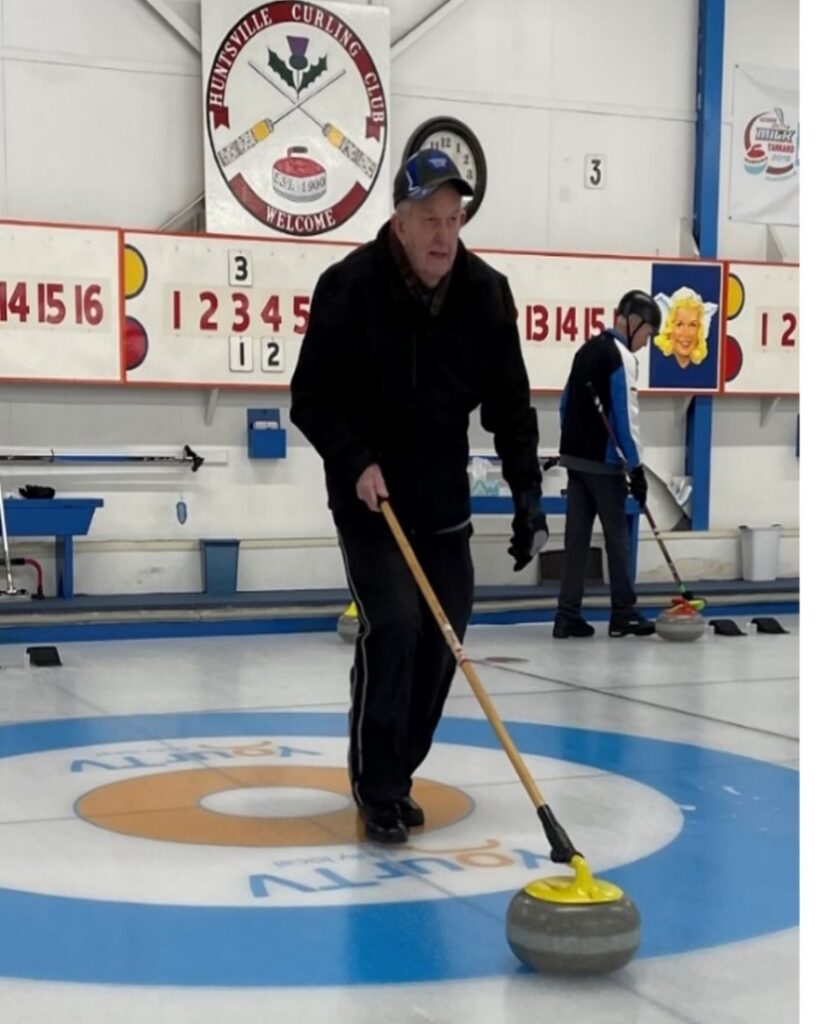
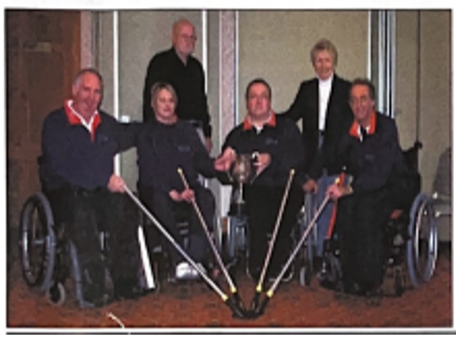
Pictured on the left, Rusty (top left), in November 2005, had been invited by Kate Caithness (top right) of Scottish Curler Magazine to attend the British Open Wheelchair event at the Kinross Curling Club in Scotland, the oldest curling club in the world, and meet the curlers using his stick here.
Ironically, Rusty was not a curler but he changed the sport of curling for the better forever. Rusty Drew, the inventor of the curling stick he called the ExtendeR cue used by curlers who require an accessibility world wide, and the person credited with creating the Sport of Wheelchair Curling, passed in 2008.
On hearing of his passing, Scottish Curler magazine wrote “many of us ‘standy uppies’ who use the cue also have a lot to thank him for”.I’ll be thinking of him when I take to the ice on Monday with my own ExtendeR cue in hand!

